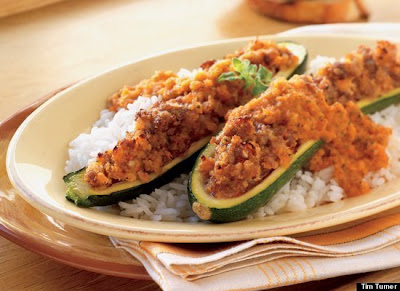Planning a Tokyo trip anytime soon? Let this article from The Guardian take you on a cyber tour to some of Tokyo's best high-end restaurants:
Kozue
No other restaurant in Tokyo has a setting to rival Kozue.
Perched far above the fray on the 40th floor of the Park Hyatt, Kozue is still
as swish as the day it opened in 1994, with a contemporary look (soaring
ceiling, stylish tables and chairs) to match the confident modern inflections
on kaiseki (japan's version of haute cuisine). The menu features torafugu
puffer fish in winter, ayu sweetfish in summer, matsutake mushrooms in autumn,
and year-round shabu-shabu of perfectly marbled beef from premium wagyu cattle.
Book a window seat to enjoy a peerless view of the western hills and even (if
the weather gods are smiling) Mt Fuji's cone silhouetted in the distance.
Park Hyatt Hotel, 3-7-1-2 Nishi-Shinjuku, Shinjuku-ku, +81
3 5323 3460, tokyo.park.hyatt.com, lunch from ¥3900 (around £34), dinner from
£115. Open daily 11.30am-2.30pm and 5.30pm-10pm, closed Wed. English spoken
Mikawa Zezankyo
Tetsuya Saotome at Mikawa Zezankyo. Photograph: detsugu on
Flickr/some rights reserved
Tetsuya Saotome produces flawless tempura, succulent morsels
of premium seafood and vegetables served straight from his deep-frying wok to
your plate. He follows the classic Edomae style, using only ingredients that
(with a couple of exceptions) would have been available 150 years ago. He works
solo, which is why he can only seat nine at his counter. The cuisine and
configuration may be traditional, but the eclectic decor – from European
antiques to traditional lacquer-work and an extractor hood in the shape of a
fedora – certainly isn't. There are many contenders for the crown of Tokyo's
finest tempura, but none take it to quite the same level of idiosyncratic
artistry. Zezankyo is hidden away in the residential back streets to the east
of the Sumida river, but it well repays the effort and taxi fare to get there.
1-3-1 Fukuzumi, Koto-ku, +81 3 3643 8383, lunch from £90,
dinner from £140, mikawa-zezankyo.jimdo.com. Open Thurs-Tues 11.30am-1.30pm and
5pm-9pm. English not spoken
Nodaiwa
The speciality at Nodaiwa is unagi, charcoal-broiled
freshwater eel. This is one of Tokyo's unsung plebeian pleasures, but here served
with refinement and a grand setting – a transplanted timber mountain farmhouse.
The fifth-generation owner-chef uses eel caught in the wild rather than from
fish farms and the flavour is incomparable. The cosy ground-floor dining room
is fine for a simple (but rich and satisfying) lunch of unaju (juicy eel
fillets broiled golden-brown, on a bed of white rice). Up the stately
staircase, the private rooms are best for a full banquet. The highlight:
shirayaki, eel that's lightly steamed and grilled, then topped with caviar.
Perfect with a bottle of crisp local koshu wine.
1-5-4 Higashi-Azabu, Minato-ku, +81 3 3583 7852,
nodaiwa.com, set menu £60, a la carte from £17. Open 11am-1.30pm and 5am-8pm.
Some English spoken
Nihon Ryori Ryugin
Ryugin sprang to prominence on the back of chef Seiji
Yamamoto's imaginative application of modern cooking techniques to classic
Japanese cuisine. These days, he has no need for any molecular magic: his
vibrant contemporary kaiseki speaks for itself. Yamamoto is now at the top of
his game (as recognised by his third Michelin star), drawing massive depths of
flavour from his premium ingredients – such as sakuradai snapper, from the
Naruto Strait close to his hometown, creamy an-kimo (monkfish liver, known as
the foie gras of the ocean), or hand-reared Iwate wagyu beef. Yamamoto's candy
pear dessert nitro-chilled to -196C and served with a sauce of the same fruit
heated to a scalding 99C, is the stuff of legend.
Side Roppongi Building 1F, 7-17-24 Roppongi, Minato-ku,
+81 3 3423 8006, nihonryori-ryugin.com, dinner £200. Open Mon-Sat 6pm-1am (last
sitting 10.30pm). English spoken
Aronia de Takazawa
Chef Yoshiaki Takazawa's bijou restaurant has long been one
of Tokyo's most intriguing secrets, more talked about than actually visited.
Hardly surprising, since Aronia only sits two tables (maximum eight people)
each evening. His French-Japanese signature dishes include: a ratatouille
terrine, with vegetables layered into multicoloured cubes; carpenter's salade
niçoise, with sashimi tuna and tapenade sauce solidified in the shape of
spanners and screws; and his hot balloon of seafood slow-cooked with bamboo
shoot and seaweed. Takazawa stands centre-stage in this hushed, windowless
chamber, with its sleek wood panelling and dramatic spot lighting, preparing or
finishing each course himself, while his wife Akiko serves and explains in
faultless English.
Sanyo Akasaka Bldg 2F, 3-5-2 Akasaka, Minato-ku, +81 3
3505 5052, aroniadetakazawa.com, from £140. Open daily 6pm-9pm (last sitting).
English spoken
Narisawa
Creativity lies at the heart of the eclectic modern cuisine
dreamed up by Yoshihiro Narisawa at his impeccably polished Aoyama restaurant,
with its swish, modern dining room and gleaming kitchen revealed through
massive picture windows like a balletic silent movie. The fundamentals may be
French but Narisawa's ideas and execution are his own: from the foraged herbs
and edible soil to the damper-style bread cooked at the table. At times, it all
feels overly cerebral, but his delectable char-cooked vegetables and wagyu beef
bring a sensual satisfaction, and the desserts seem to never stop arriving.
Narisawa also boasts a cellar especially strong in Burgundies, as well as a
groaning cheese trolley.
2-6-15 Minami-Aoyama, Minato-ku, +81 3 5785 0799,
narisawa-yoshihiro.com, lunch from £65, dinner from £185. Open Mon-Sat noon-3pm
and 6.30-9pm. English spoken
Sushi Mizutani
Sushi doesn't get much finer than at Mizutani – or more
austere. There is virtually no decoration on the plain ochre walls of the small
9th-floor room where Hachiro Mizutani holds court. Nor are there tables, just
one long counter; a single massive timber of smooth-scrubbed cedar and 10 plain
chairs. The air is crisp with the faint aroma of rice vinegar and the
atmosphere is hushed. Sushi veteran Mizutani is taciturn in his own language
and speaks no English, but there's little that needs saying, except to specify
beer or sake (there's only one brand of each). The sushi arrives in a set
order, determined according to whatever is in peak season. A succession of
flawless morsels of seafood on lightly vinegared rice kept at exactly skin
temperature, it will include several cuts of the finest bluefin you have ever
tasted, and the best abalone too. A couple of caveats: perfume is frowned upon,
as are cameras and mobile phones. Nothing is allowed to disturb the serenity.
Juno Ginza Seiwa Building 9F, 8-7-7 Ginza, Chuo-ku, +81 3
3573 5258, lunch from £130, dinner from £180. Open Mon-Sat 11.30am-1.30pm and
5pm-9.30pm. English not spoken
Tofuya Ukai
In a city of contrasts and surprises, few are greater than
discovering the traditional garden, carp ponds and sprawling low-rise wooden
architecture at Tofuya Ukai. There is no central dining room, just a warren of
private chambers (most with tatami mats and low tables, but some with chairs)
with garden views built around the timber buildings of a former sake brewery.
The multi-course kaiseki meals focus on tofu, produced freshly at Ukai's own
small workshop in the hills west of Tokyo. In winter, the house-special
tosui-tofu delivers a triple whammy of bean goodness: cubes of tofu cooked down
at your table in a creamy, savoury casserole of soya milk blended with chicken
broth, topped with layers of yuba tofu skin
4-4-13 Shiba-Koen, Minato-ku, +81 3 3436 1028, ukai.co.jp,
lunch from £50, dinner from £75. Open daily 11am-10pm (last sitting 8pm).
English spoken
Bird Land Ginza
Toshihiro Wada was one of the first artisan chefs to elevate
the humble craft of grilling skewers of chicken (yakitori) to a cuisine of
substance and subtlety. He uses only top-quality free-range shamo gamecock,
cooking the morsels of meat and offal over premium Bincho charcoal. Open the
meal with his trademark liver pate, continue with wasabi-coated rare sasami
white meat, and don't miss the sansho-yaki, succulent breast meat dusted with
piquant Japanese pepper. In another break from the tradition of smoky
neighbourhood grills, Wada stocks a small cellar of Burgundies and New World
wines – perfect with grilled fare of this caliber.
Tsukamoto Building B1F,
4-2-15 Ginza, Chuo-ku, +81 3 5250 1081, ginza-birdland.sakura.ne.jp, dinner
from £55. Open Tue-Sat 5pm-9.30pm. Some English spoken
Akasaka Kikunoi
From the bamboo-lined, lantern-lit path to the simple,
traditional wooden decor of the rooms (with either chairs or tatami mats),
Kikunoi is a microcosm of traditional Kyoto. The Tokyo outpost of one of
Kyoto's most illustrious kaiseki houses, it serves the rarified cuisine of
Japan's ancient capital – expect to spend a good three hours at table if you're
having the full-course dinner. For a more concise, affordable introduction, the
lunchtime Kodaiji bento is an exquisite tasting menu in miniature, served in a
lacquered box with several side dishes. Owner-chef Yoshihiro Murata is revered
for the depth of umami he coaxes from the dashi soup stock that underpins all
his dishes.
6-13-8 Akasaka, Minato-ku, +81 3 3568
6055, kikunoi.jp, lunch from £45, dinner from £140. Open Mon-Sat noon-1pm and
5pm-9pm (last sitting). English spoken
For more information go to the Japan National Tourism
Organisation's website:
jnto.go.jp/eng
Log on to JC Uni-tec's website for more information on Japanese cuisine.




























